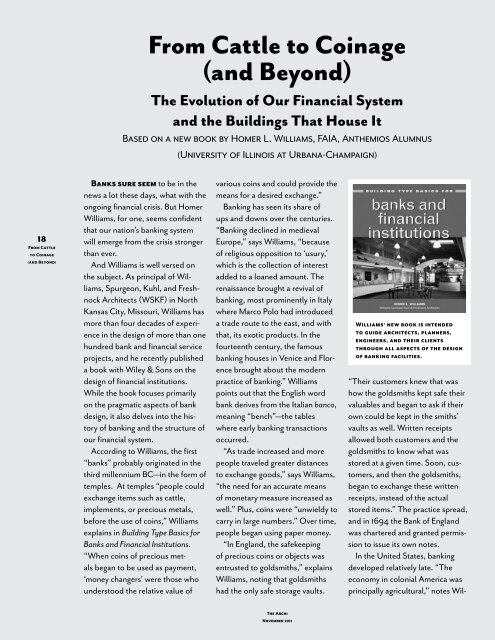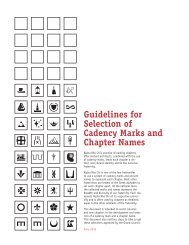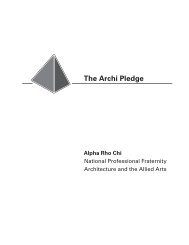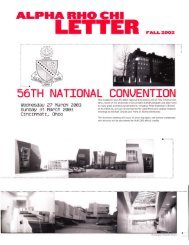The Archi - November 2011 - Alpha Rho Chi
The Archi - November 2011 - Alpha Rho Chi
The Archi - November 2011 - Alpha Rho Chi
Create successful ePaper yourself
Turn your PDF publications into a flip-book with our unique Google optimized e-Paper software.
From Cattle to Coinage<br />
(and Beyond)<br />
<strong>The</strong> Evolution of Our Financial System<br />
and the Buildings That House It<br />
Based on a new book by Homer L. Williams, FAIA, Anthemios Alumnus<br />
(University of Illinois at Urbana-Champaign)<br />
18<br />
From Cattle<br />
to Coinage<br />
(and Beyond)<br />
Banks sure seem to be in the<br />
news a lot these days, what with the<br />
ongoing financial crisis. But Homer<br />
Williams, for one, seems confident<br />
that our nation’s banking system<br />
will emerge from the crisis stronger<br />
than ever.<br />
And Williams is well versed on<br />
the subject. As principal of Williams,<br />
Spurgeon, Kuhl, and Freshnock<br />
<strong>Archi</strong>tects (WSKF) in North<br />
Kansas City, Missouri, Williams has<br />
more than four decades of experience<br />
in the design of more than one<br />
hundred bank and financial service<br />
projects, and he recently published<br />
a book with Wiley & Sons on the<br />
design of financial institutions.<br />
While the book focuses primarily<br />
on the pragmatic aspects of bank<br />
design, it also delves into the history<br />
of banking and the structure of<br />
our financial system.<br />
According to Williams, the first<br />
“banks” probably originated in the<br />
third millennium BC—in the form of<br />
temples. At temples “people could<br />
exchange items such as cattle,<br />
implements, or precious metals,<br />
before the use of coins,” Williams<br />
explains in Building Type Basics for<br />
Banks and Financial Institutions.<br />
“When coins of precious metals<br />
began to be used as payment,<br />
‘money changers’ were those who<br />
understood the relative value of<br />
various coins and could provide the<br />
means for a desired exchange.”<br />
Banking has seen its share of<br />
ups and downs over the centuries.<br />
“Banking declined in medieval<br />
Europe,” says Williams, “because<br />
of religious opposition to ‘usury,’<br />
which is the collection of interest<br />
added to a loaned amount. <strong>The</strong><br />
renaissance brought a revival of<br />
banking, most prominently in Italy<br />
where Marco Polo had introduced<br />
a trade route to the east, and with<br />
that, its exotic products. In the<br />
fourteenth century, the famous<br />
banking houses in Venice and Florence<br />
brought about the modern<br />
practice of banking.” Williams<br />
points out that the English word<br />
bank derives from the Italian banco,<br />
meaning “bench”—the tables<br />
where early banking transactions<br />
occurred.<br />
“As trade increased and more<br />
people traveled greater distances<br />
to exchange goods,” says Williams,<br />
“the need for an accurate means<br />
of monetary measure increased as<br />
well.” Plus, coins were “unwieldy to<br />
carry in large numbers.” Over time,<br />
people began using paper money.<br />
“In England, the safekeeping<br />
of precious coins or objects was<br />
entrusted to goldsmiths,” explains<br />
Williams, noting that goldsmiths<br />
had the only safe storage vaults.<br />
Williams’ new book is intended<br />
to guide architects, planners,<br />
engineers, and their clients<br />
through all aspects of the design<br />
of banking facilities.<br />
“<strong>The</strong>ir customers knew that was<br />
how the goldsmiths kept safe their<br />
valuables and began to ask if their<br />
own could be kept in the smiths’<br />
vaults as well. Written receipts<br />
allowed both customers and the<br />
goldsmiths to know what was<br />
stored at a given time. Soon, customers,<br />
and then the goldsmiths,<br />
began to exchange these written<br />
receipts, instead of the actual<br />
stored items.” <strong>The</strong> practice spread,<br />
and in 1694 the Bank of England<br />
was chartered and granted permission<br />
to issue its own notes.<br />
In the United States, banking<br />
developed relatively late. “<strong>The</strong><br />
economy in colonial America was<br />
principally agricultural,” notes Wil-<br />
<strong>The</strong> <strong>Archi</strong><br />
<strong>November</strong> <strong>2011</strong>







